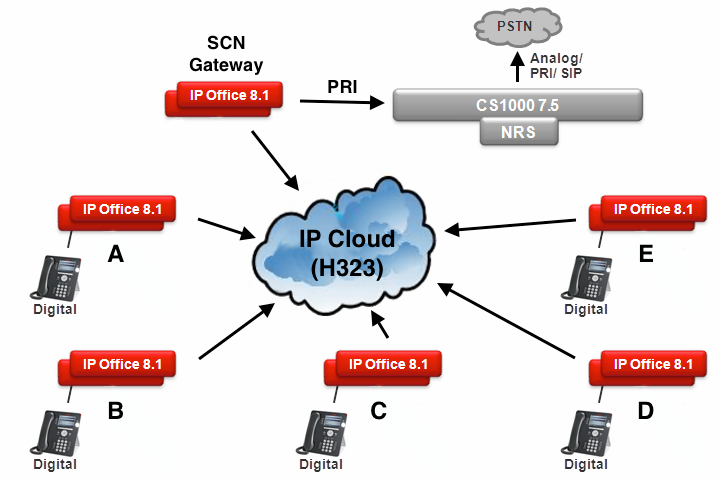SCN Dialing
This tutorial explains how to configure an SCN, and the ability to dial from a remote site, across an SCN network, to the main site’s trunks. The tutorial is divided into two sections, the first of which explains the configuration of Site A (the main site where the external trunks reside), and the second of which explains the configuration of site B (the remote site which needs to dial across the SCN, in order to utilize Site A’s trunks).
Site A:
- Address scheme:
- IP Office LAN 1: 192.168.42.1
- Subnet Mask: 255.255.255.0
- Default Gateway: 192.168.42.200
- Licenses/Hardware:
- Confirm a valid Voice Networking license is installed.
- Confirm a VCM or Combo card is installed.
- Create a new H.323 Line:
- VoIP Settings
- Gateway IP Address: 192.168.43.1 (Site B IP Office address)
- Supplementary Services: IP Office SCN
- Code: 9N
- Feature: Dial
- Telephone: N
- LGID: 50:Main (local ARS table where external calls are routed)
- Create a new IP Route:
- This is a default route that will route traffic from any IP address/mask via LAN1. In cases where more granular routing is required, this route may need to be changed, but this works for most deployments:
- IP Address: 0.0.0.0
- Subnet Mask: 0.0.0.0
- Gateway IP Address: 192.168.42.200 (local gateway on this network)
- Destination: LAN1
Site B:
- Address scheme:
- IP Office LAN 1: 192.168.43.1
- Subnet Mask: 255.255.255.0
- Default Gateway: 192.168.43.200
- Licenses/Hardware:
- Confirm a valid Voice Networking license is installed.
- Confirm a VCM or Combo card is installed.
- Create a new H.323 Line:
- VoIP Settings
- Gateway IP Address: 192.168.42.1 (Site A IP Office address)
- Supplementary Services: IP Office SCN
- Outgoing Group ID: 1
- IP Route:
- IP Address: 0.0.0.0
- Subnet Mask: 0.0.0.0
- Gateway IP Address: 192.168.43.200 (local gateway on this network)
- ARS Table:
- Edit the existing ARS codes (in this example the 1N code is used, but the same must be done for all of the other ARS codes as well):
- Code: 1N
- Feature: Dial
- Telephone: 9N (send an extra 9 to trigger outbound dialing rules when the call is received by Site A)
- LGID: 1 (the LGID of the local H.323 line)
Troubleshooting:
You should now be able to make calls from Site B, out of site A’s trunks. If you are unable to make calls, here are some troubleshooting steps:
- Edit the existing ARS codes (in this example the 1N code is used, but the same must be done for all of the other ARS codes as well):
- VoIP Settings
- This is a default route that will route traffic from any IP address/mask via LAN1. In cases where more granular routing is required, this route may need to be changed, but this works for most deployments:
- VoIP Settings

